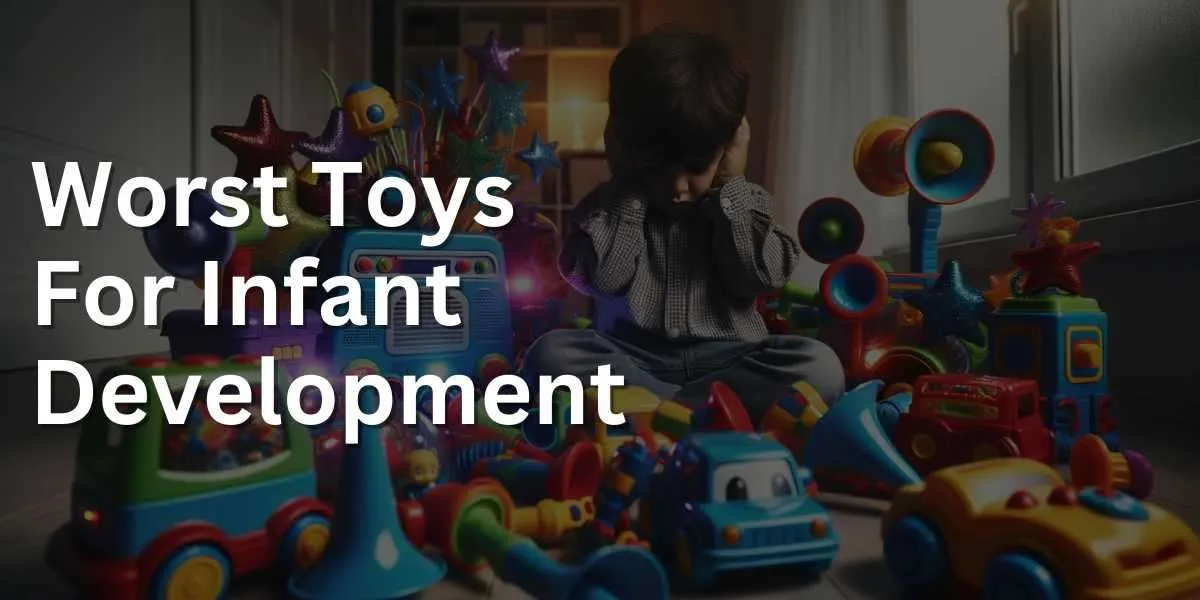While many toys promise to benefit infants, there are some that might do the opposite. Addressing the worst toys for infant development is essential for parents and caregivers aiming to provide the best environment for their little ones.
Certain toys, despite their flashy appeal, may not be conducive to an infant’s growth and might even pose risks. Whether it’s due to inappropriate materials, a lack of stimulation, or potential safety hazards, it’s vital to be informed about these less-than-ideal options. This article will shed light on toys that might not be suitable for infants, highlighting the reasons they might impede developmental progress.
Eager to ensure your infant’s play environment promotes optimal development? Join us as we navigate the toys that might not make the cut and the reasons behind their limitations.
Key Takeaways on What Toys Are Bad for Babies
- Overly Stimulating Toys:
- Excessive Lights and Sounds: Toys that are too flashy or noisy can overstimulate an infant, leading to restlessness or difficulty in focusing.
- Limit Learning: Overly complex toys can hinder an infant’s natural curiosity and exploration.
- Choking Hazards:
- Small Parts: Toys with detachable small parts or that can be easily broken into small pieces pose a choking risk.
- Strings and Cords: Toys with long strings or cords can be a strangulation hazard.
- Toxic Materials:
- Harmful Chemicals: Toys made from materials that contain phthalates, lead, or other harmful chemicals can be dangerous if ingested or even touched.
- Non-BPA Free Plastics: Some plastics can release harmful chemicals, especially when chewed or sucked.
- Inappropriate Age Recommendations:
- Advanced Toys: Toys meant for older children can be frustrating or even dangerous for infants if they have complex mechanisms or small parts.
- Oversimplified Toys: Conversely, toys that are too basic for the infant’s developmental stage can limit their learning and exploration.
- Loud Toys:
- Hearing Damage: Toys that produce very loud sounds can damage an infant’s sensitive hearing or cause them distress.
- Immovable or Rigid Toys:
- Limited Interaction: Toys that don’t allow for much interaction or manipulation can limit the development of fine motor skills and tactile exploration.
- Non-Washable Toys:
- Hygiene Issues: Infants often put toys in their mouths. Toys that can’t be easily cleaned can harbor germs or allergens.
- Poorly Constructed Toys:
- Breakage and Injury: Toys that break easily can result in sharp edges, posing a risk of cuts or other injuries.
- Over-reliance on Electronic Toys:
- Passive Learning: While some electronic toys can be educational, over-relying on them can limit the infant’s opportunities for active, hands-on learning.
Bad toys for babies include standing activity centers, sit-me-up floor seats, and plastic seats like the Bumbo. These toys do not encourage natural movement and can even lead to abnormal development.
Jumpers and baby walkers are not recommended as they can cause accidents and delay your child’s motor skills development.
It’s important to note that not all toys marketed for infants are safe or beneficial for their development. Some toys can cause harm and hinder their long-term growth.
Worst Toys for Infant Development
Certainly, there are specific toys that experts often caution against when considering infant development. Toys with small detachable parts are at the top of the list due to the choking hazard they pose, as infants instinctively mouth objects to explore their environment.
Loud electronic toys can be overwhelming for an infant’s developing auditory system and may also distract from more meaningful forms of engagement. Toys with bright, flashing lights can overstimulate an infant, potentially disrupting their visual development.
Then there are toys that are too complex for an infant’s developmental stage, which can lead to frustration rather than learning. Toys made from non-child-safe materials or those with toxic paints and coatings can be harmful if ingested or can cause allergic reactions. It’s essential for caregivers to select toys that are age-appropriate, made from safe materials, and promote active, exploratory play to ensure healthy infant development.
- Noise-making toys – Toys that make loud, annoying noises and sounds overstimulate kids and make it hard for them to focus. They may also damage hearing over time.
- TV/media-based toys – Toys like tablets, smartphones, and those based on TV shows don’t allow for creative play. They can be overstimulating and addicting.
- Violent toys – Toys with violent themes like guns, swords and realistic combat toys desensitize kids to aggression. They may encourage unsafe play.
- Toxic toys – Avoid old or cheap plastic toys as they may contain toxic chemicals like lead and phthalates. These can harm brain and physical development.
- Baby walkers – Research shows baby walkers can delay motor development. Babies learn by crawling first. Walker injuries are also common.
- Too many plastic toys – Limit plastic in favor of more natural materials like wood, cloth and metal. Varied textures stimulate senses.
- Fast-paced electronic toys – Noisy, flashing, racing toys overstimulate developing brains. Simple cause-and-effect toys are better.
- Screen time before age 2 – Media exposure before age 2 is linked with language delays, attentional issues and obesity later on.
- Unintended use toys – Avoid toys with small parts not meant for kids as they pose choking hazards and can cause injuries.
In general, the best toys for young kids are simple, open-ended, imaginative and sensory-based. Toys that spark creativity, get kids moving and allow for interactive play with others tend to be the most beneficial for development.
Too Small Toys Are Bad Toys for Infants
Absolutely, toys that are too small pose a significant hazard for infants due to the risk of choking. Infants have a natural tendency to explore their environment by putting objects into their mouths, and small toys or parts can easily become lodged in their throats.
Beyond the immediate physical danger, toys that are not size-appropriate for infants may not provide the right kind of stimulation or developmental challenge. For instance, tiny toys might not aid in enhancing their motor skills or hand-eye coordination, which larger, graspable toys can help develop. It’s also essential for caregivers to consider the toy’s durability.
If a toy breaks easily, it might produce small parts that weren’t initially a choking hazard. As a guideline, any toy or part small enough to fit inside a toilet paper roll is generally considered unsafe for infants. It’s crucial for parents and caregivers to scrutinize toy sizes and ensure they are appropriate for an infant’s age and developmental stage.

Choking Hazards
Small toys, including those with small parts, pose a choking hazard to infants. Infants have a natural tendency to put objects in their mouths, and small toys can easily become lodged in their throats, blocking their airways and causing suffocation.
According to the American Academy of Pediatrics, toys that can fit through a toilet paper roll are too small for infants and should be avoided. Examples of small toys that pose a choking hazard include:
- Beads
- Marbles
- Balls with a diameter of less than 1.75 inches
- Small building blocks
Swallowing Hazards
Small toys can also pose a swallowing hazard to infants. If a toy is small enough to fit in an infant’s mouth, it can be swallowed and cause serious internal injuries. This is particularly dangerous if the toy has sharp edges or is made of toxic materials.
Examples of small toys that pose a swallowing hazard include:
- Toy cars with small wheels
- Small figurines
- Small puzzle pieces
- Toy jewelry
To avoid these hazards, it is important to carefully read the labels and warnings on toys before purchasing them. Always choose toys that are appropriate for your child’s age and development level, and avoid toys with small parts or sharp edges that could be harmful.
Why Electronic Toys Are Bad for Child Development
Electronic toys, especially those that promote passive engagement, have raised concerns regarding their impact on child development. Many of these toys come with pre-programmed responses and don’t allow children to exercise their creativity or problem-solving skills. Instead of actively exploring and learning through play, children often become mere spectators, leading to reduced cognitive stimulation.
Electronic toys that have bright screens can interfere with the development of a child’s visual system and may contribute to shorter attention spans. Excessive exposure to such toys can also detract from essential physical activity, leading to sedentary behavior and associated health concerns.
Toys that generate a lot of noise or guide play with repetitive instructions can limit the development of independent thought and imagination. While some electronic toys can be educational and enhance learning, it’s crucial to strike a balance. Prioritizing toys that promote active learning, creativity, and physical activity is key to ensuring holistic development in children.

Overstimulation
Electronic toys often have bright lights, loud noises, and flashy displays that can be overwhelming for infants. Overstimulation can cause stress and anxiety, leading to difficulty sleeping and irritability.
Children who are exposed to too much stimulation may also have trouble focusing and paying attention later in life.
Overstimulation can lead to a decrease in a child’s creativity and imagination. Traditional toys, such as building blocks, action figures and dolls, encourage children to use their own imaginations to create their own stories and scenarios.
And nothing beats human interaction, if your child needs a hug or cuddle, don’t give them toys.
Lack of Interaction
Another issue with electronic toys is that they often lack the social interaction that is crucial for an infant’s development. Children learn best through social interaction and communication with others. Electronic toys, however, often provide one-way communication and do not allow for the back-and-forth interaction that is necessary for language development.
Research has shown that infants who are exposed to electronic toys with pre-recorded messages and songs have a lower quality and quantity of language compared to those who play with traditional toys or engage in face-to-face interaction with caregivers.
Furthermore, electronic toys can hinder a child’s ability to develop social skills, such as sharing and taking turns. Traditional toys that require interaction with others, such as board games and puzzles, can help children develop these important social skills.
Toys with Sharp Edges or Points Are Bad Baby Toys
When choosing toys for infants, it’s important to avoid those with sharp edges or points. These types of toys can pose severe injury risks to young children, especially when they are still learning to grasp and manipulate objects. Here are some things to consider when looking for safe toys for your infant:

Injury Risks
Sharp edges or points on toys can cause serious injuries to young children. Infants are especially vulnerable to these types of injuries because they are still developing their motor skills and coordination. Toys with sharp edges or points can cause cuts, scratches, and even eye injuries if they are not handled properly.
It’s important to carefully inspect all toys before giving them to your infant. Look for any sharp edges or points that could pose a risk, and make sure that all parts of the toy are securely attached. Be especially cautious when giving your infant toys with small parts or pieces that could be swallowed or choked on.
When selecting toys for your infant, choose those that are made from soft, pliable materials that won’t cause harm if they are accidentally dropped or thrown. Avoid toys made from hard plastic or metal, which can be dangerous if they break or shatter.
Toys with Loud Noises
Toys with loud noises can be detrimental to child development for several reasons. Firstly, continuous exposure to high-decibel sounds can pose a risk to a child’s hearing. Young children, especially infants, have delicate eardrums that can be easily damaged by loud noises.
Over time, this can lead to hearing loss or sensitivity to sound. Beyond the physical implications, toys with disruptive noises can also interfere with a child’s cognitive development. Instead of focusing on the play’s educational or imaginative aspect, the child becomes conditioned to respond solely to the noise, leading to reduced attention spans and limited exploration.
Such toys can be counterproductive in teaching children about sound modulation and social etiquette, as they might not understand the importance of speaking softly or maintaining a quiet environment when needed. Parents and caregivers should be mindful of the noise level when selecting toys and prioritize those that offer a more enriching and less disruptive play experience.

FAQs on Toys Which Are Bad for Infant Development
Can too many toys harm a child’s development?
Yes, having too many toys can potentially harm a kid’s development. An excess of toys can lead to overstimulation, reduced creativity, and difficulty focusing on a single task. It may also hinder the development of problem-solving skills, as children may not spend enough time with one toy to explore it fully and learn from it.

What are some of the most dangerous toys for babies?
There are several toys that are potentially dangerous for babies, including those with small parts that can be swallowed or choked on. Toys with strings or cords longer than 6 inches also pose a strangulation hazard, as do toys with sharp edges or points that can cause injury.
Battery-operated toys can also be dangerous if the battery compartment is easily accessible and the batteries are swallowed, causing serious injury or even death.
Finally, toys with loud noises or bright flashing lights can be harmful to a baby’s sensory development and should be avoided. It’s important for parents to carefully inspect all toys before giving them to their babies and to follow safety recommendations and guidelines from the Consumer Product Safety Commission.
Is the woman battle action sword good for kids?
While this toy is good for imaginative play, there are other toys that are better and safer such as stuffed animals and pull toys.

Is Jetts Heel Wheels safe?
Jhett Heel Wheels are a type of roller skates that attach to the heel of a shoe, allowing the user to skate with their feet facing forward. As with any activity involving wheels, there are some potential safety concerns that should be taken into consideration.
Are crib toys safe?
Crib toys can be safe if they are used appropriately and are designed for use in a crib. However, there are some important safety considerations to keep in mind.





